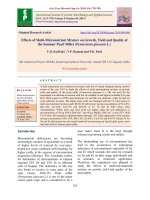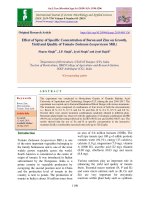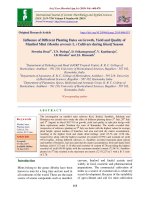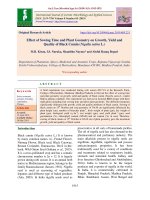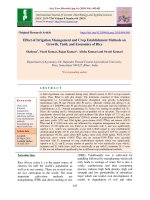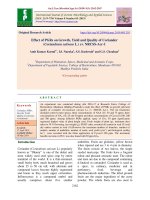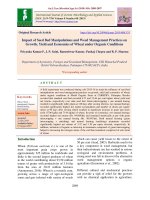Effect of row spacing on growth, yield and economics of direct seeded rice in eastern vidharbha zone of Maharashtra, India
Bạn đang xem bản rút gọn của tài liệu. Xem và tải ngay bản đầy đủ của tài liệu tại đây (367.13 KB, 12 trang )
Int.J.Curr.Microbiol.App.Sci (2018) 7(7): 2930-2941
International Journal of Current Microbiology and Applied Sciences
ISSN: 2319-7706 Volume 7 Number 07 (2018)
Journal homepage:
Original Research Article
/>
Effect of Row Spacing on Growth, Yield and Economics of Direct Seeded
Rice in Eastern Vidharbha Zone of Maharashtra, India
Usha R. Dongarwar1, Nitin Patke2, L. N. Dongarwar3 and Sumedh R. Kashiwar4*
1
Krishi Vigyan Kendra, Bhandara (Sakoli), Maharashtra - 441802, India
Zonal Agricultural Research Station, Sindewahi, Maharashtra - 441222, India
3
Dr. Panjabrao Deshmukh Krishi Vidhyapeeth, Akola, Maharashtra – 444001, India
4
Institute of Agriculture, Visva-Bharati, Santiniketan, West Bengal - 731236, India
2
*Corresponding author
ABSTRACT
Keywords
Drilled rice, DSR,
spacing, Vidharbha,
PKV HMT
Article Info
Accepted:
20 June 2018
Available Online:
10 July 2018
The field experiments were conducted in the kharif seasons of 2013-2014, 2014-2015, and
2015-2016 at the research farm of Krishi Vigyan Kendra, Bhandara (Sakoli) and Zonal
Agricultural research Station, Sindewahi. The experiments were laid out in Randomized
Block Design (RBD) with three replications and eight treatments. Higher number of
effective tillers (390.0 m-2) observed in T2:- Row spacing 20cm x plant-to-plant spacing 10
cm at both the locations. The pooled mean of grain yield at two location and three seasons
revealed that the row spacing of T 2- 20 cm x plant-to-plant spacing 10 cm (3376 Kgha-1)
was highest over all other treatments and it was par with T 1. The highest GMR, NMR and
B: C ratio has recorded in T 2 followed by treatment T1. Sowing of drill rice at row spacing
of 20 cm and plant to plant spacing of 10 cm (T 2) was highest in grain yield (3376.49 kg
ha-1), GMR, NMR and B:C ratio (1.91) over other treatments and it was at par with 20x15
cm drilling of rice with grain yield (3305.46 kgha-1) GMR,NMR and B:C ratio (1.86).
Introduction
Rice (Oryza sativa L.) is grown in regions
having the necessary warmth and abundant
moisture favorable to its growth, be it under
lowland or upland condition. It is one of the
most important and indispensable caloric
cereal food crop. Beyond providing
sustenance through growing, earning income,
and consuming, rice plays an integral, but
important cultural role in many rural
communities. For instance, products of rice
plant are used for a number of purposes, such
as fuel, thatching, industrial starch, artwork,
and festivities (Gangwar et al., 2008). No
groundwater recharge in rainy (kharif) season,
late commencement of monsoon and farm
operations often delays rice (Oryza sativa L.)
transplanting which leads to late vacation of
fields, forcing farmers to plant wheat after the
optimum sowing time (Singh et al.,2005).
Labour shortage at the time of transplanting
leads to delay in transplanting and it is one of
the reasons for low yields of rice.
Transplanted rice in puddled field requires
continuous standing water although this leads
to nutrient loss through leaching. Although
puddling helps in reducing water losses
2930
Int.J.Curr.Microbiol.App.Sci (2018) 7(7): 2930-2941
through percolation and controlling weed by
submergence of rice fields, but besides being
costly, bulky and time intense, it results in
degradation of soil and other natural
resources, and afterwards poses difficulties in
seedbed preparation for succeeding next crop
in crop rotation. Transplanting of rice mainly
done by migratory labour, which has an
element of seasonality and thus becoming a
serious concern for timely transplanting of rice
and maintaining a plant population sufficient
to achieve the higher rice productivity (Gupta
et al., 2006, Dongarwar et al., 2018a,
Dongarwar et al., 2018b, Kashiwar et al.,
2016). Rice production systems are
undergoing various changes, one of which is a
shift from transplanting to direct seeding as
farmers seek alternatives to offset increasing
costs. The main driving force for this changes
are the rising wage rates, scarcity of labour
and at the same time, the availability of option
to manage weeds in direct-seeded rice
(Mahajan et al., 2009). In Maharashtra state of
India, rice is cultivated on 15.13 lakh hectares
area in nearly all four regions named
Vidharbha (7.95 lakh ha.), Konkan (3.83 lakh
ha.), Western Maharashtra (3.23 lakh ha.) and
Marathwada (0.12 lakh ha.) with annual
production of 41.71 lakh tons unmilled (brown
rice) and 28.78-lakh tons milled rice. The area
(7.95 lakh ha.) and production (16.81 lakh
tons unmilled rice) of rice crop is more in
Vidharbha
region
while
as
highest
productivity was observed in Konkan region
(2.75 t ha-1) (AMSEWPR 2014). Row spacing
has a great impact on plant density and the
competitiveness of the crop stand, tiller, time
to maturity and yield. Low plant density and
improper sowing method are the most
important factors of agronomic constraints for
obtaining higher yields and have a positive
influence on the yield of rice. Optimum plant
density is the primary factor for obtaining
higher yield in rice (Sivaesarajah et al., 1995).
The increase in plant density increases total
plant weight per unit area and decreases the
total weight per plant (Yoyock et al., 1979).
The number of plants per unit area has an
impact on plant architecture, modifies growth
and development pattern and effects on the
production photosynthesis (Abuzar at. al.
2011). The increase in plant density increases
the yield up to a limit and thereafter a leveling
off or decline in yield (Sivaesarajah et al.,
1995). The reason for the reduction in yield is
due to the reduction in resources per plant. So
the reduction in yield will not be compensated
by increasing plant number. Direct seeding
technique offers a useful option to reduce the
limitations of transplanted rice. Direct seeding
is being practiced in many developed
countries where labour is scarce and expensive
(Pingali et al., 1994). Direct-seeded rice
occupies 26% of the total rice area in South
Asia (Gupta et al., 2006). Direct seeding of
rice avoids puddling, does not need
continuous submergence, and thus reduces the
overall water demand for rice culture. When
rainfall at planting time is highly variable,
direct seeding may help reduce the production
risk (Singh et al., 2006). Direct seeding can
also reduce the risk by avoiding terminal
drought that lowers the yield of transplanted
rice, especially if the latter is established late
due to delayed rainfall. Direct seeding can
facilitate crop intensification (Singh et al.,
2008). In Vidharbha region of Maharashtra,
rice is majorly grown by puddled transplanting
method, which is laborious and costly method.
The peak period of rice transplanting is in the
month of July, which results in labour
shortage at the time of transplanting. For this
instance, the present study aimed to find out
the suitable seed rate for bold and fine seeded
rice under drill condition, effect of different
seed rates on yield and yield attributing
characters of drilled rice and the economics.
Materials and Methods
Study aimed to investigate, the effect of
different spacing’s on growth, yield and
2931
Int.J.Curr.Microbiol.App.Sci (2018) 7(7): 2930-2941
economic traits of PKV HMT rice variety.
Study conducted during three rainy (kharif)
seasons of 2013, 2014 and 2015 at two
locations Krishi Vigyan Kendra, Bhandara
(Sakoli), Maharashtra, India and Zonal
Agricultural Research Station, Sindewahi,
Maharashtra, India. The experiment laid in
Randomized Block Design having three
replications and eight treatments. The
experimental material comprised of wellknown rice variety named PKV-HMT with
eight different treatment combinations like T1Row spacing 20 cm x plant-to-plant spacing
15 cm, T2:- Row spacing 20cm x plant-toplant spacing 10 cm, T3- Row spacing 20 cm x
plant-to-plant spacing 20 cm, T4- Row spacing
20 cm x plant-to-plant spacing 7 cm, T5- Row
spacing 20 cm x plant-to-plant spacing 5 cm,
T6- Drilling of paddy at 20 cm spacing, T7Row spacing 25 cm x plant-to-plant spacing
25 cm, T8- Sowing by broadcasting method.
The soil of experimental site has analyzed for
initial soil nutrient status (Table 1) and date of
Sowing and harvesting has strictly followed
for consequent three years (Table 2).
Application of Pendimethaline @ 3.33 lit ha-1
within 48 hrs. After sowing and one weeding
at 30 DAS and 5 t FYM ha-1 + Azospirilum +
PSB seed treatment are common in all the
treatment combinations.
Results and Discussion
Growth and yield traits
Average results observed in growth traits as
influenced by various row spacing’s
throughout three-year shows, as row spacing
increases the plant height, grains panicle-1,
length of panicle and effective tillers sq. m1
gets affected eventually (Table 3). The
highest plant height has recorded in T1 (97.47
cm), T2 (97.0 cm) and T7 (97.00 cm) as these
were superior all over the treatments. The
lowest plant height has been recorded (91.07
cm) in T8 (Sowing by Broadcasting method).
The utmost number of tillers sq. m-1 has
recorded in T8 (826.67 sq. m-1) followed by T6
(744.67 sq. m-1), T2 (644.33 sq. m-1), T4 (635.0
sq. m-1) and lowest number of tillers has
recorded in T7 (520.33 sq. m-1).Number of
effective tillers sq. m-1 has recorded highest in
T2 (390.0 sq. m-1) followed by T7 (370.66 sq.
m-1), T1 (351.0 sq. m-1) and lowermost has
noted in T6 (275.33 sq. m-1).In terms of length
of panicle (cm), T1 (20.60 cm) followed by T2
(20.55) has found superior over all the
treatments as well as the T6 (18.20 cm) has
recorded the lowest. The Number of grains
panicle-1 has recorded high in T2 (172.92
grains panicle-1) followed by T1 (170.47 grains
panicle-1). The Grain Yield of T2 (566.67g
m-2) and T1 (500.67 g M-2) has been recorded
highest apart from these treatments (Table 3),
T8 (316.0 g m-2), T6 (350.0 g m-2), T3 (383.33
g m-2) has lowest readings. Overall the
treatment T2 (Row spacing 20 x plant-to-plant
spacing 10 cm) was superior in term of plant
height (97.0 cm), number of tillers (644.33 Sq.
m-1), number of effective tillers (390.0 Sq.
m-1), length of panicle (20.55 cm), number of
grains (172.92 panicle-1), grain yield (566.67 g
sq. m-1) and test weight (14.49 g). Miller et al.,
1991 found that panicle is a key factor that
determines and contributes 89 % of
differences in yield. These results are in line
with those of Kenneth et al., 1996 who
reported rough rice has gained high yield in
the optimum plant stand. This is in agreement
with the studies reported by Mahajan et.al
2004, Hardev et al., 2014, Dongarwar et al.,
2015, Dongarwar et al., 2018a, Dongarwar et
al., 2018b, Kashiwar et al., 2016 and Rajiv et
al., 2013.Similar results showing that yield of
rice linearly increased with seed density has
been reported by Baloch et al., 2002. The
plants at low seed population have sufficient
space and this enables to utilize more
nutrients, water and solar radiation for better
photosynthesis. This is in agreement with the
studies reported by Baloch et al., 2002, Akbar
et al., 2004, Prasad et al., 1999, IRRI 2008,
2932
Int.J.Curr.Microbiol.App.Sci (2018) 7(7): 2930-2941
Subbaiah et al., 2002, Gill et al., 2008,
Sharma et al., 1992, Mahajan et al., 2006,
Dongarwar et al., 2015, Dongarwar et al.,
2018a, Dongarwar et al., 2018b, Kashiwar et
al., 2016 and Abou-Khalifa et al., 2014.
Pooled means at ZARS, Sindewahi location
(Table 4) revealed that, row spacing T1- Row
spacing 20 cm x plant to plant spacing 15 cm
(3939.70 Kg ha-1) recorded significantly
higher as well as at par with each other in
grain yield followed by T2- Row spacing 20 x
plant to plant spacing 10 cm (3883.23 kg ha-1)
and T3- Row spacing 20 x plant to plant
spacing
20
cm
(3660.70
kg
ha-1) (Table 4). A good number of tillers give
a good number of panicles, which is a
significant component of the output, which
occurs during the vegetative phase, influenced
by factors such as the fertilization, water
stress, and other farming techniques
(Lacharme, 2001, Dongarwar et al., 2018a,
Dongarwar et al., 2018b, Kashiwar et al.,
2016, Dongarwar et al., 2015).
Pooled mean of KVK, Sakoli(Table 5)
indicated that T2 (2869.73 Kg ha-1) was
recorded significantly highest grain yield over
all other treatments followed by Treatment T1
(2671.14 kg ha-1) and T3 (2287.70 kg ha-1)
(Table 5). Treatment T8-Sowing by
broadcasting method (1852.19 kg ha-1) has
recorded the lowest pooled mean among all
the treatment combinations. Lacharme et al.,
2001; Singh et al., 2004; Gala et al., 2011 and
Sanogo et al., 2010, Dongarwar et al., 2018a,
Dongarwar et al., 2018b, Kashiwar et al.,
2016, Dongarwar et al., 2015 also report the
relevant results.
Pooled mean from three years of ZARS,
Sindewahi and KVK, Sakoli (Table 6)
indicated that T2 (3376.49 Kg ha-1) was
recorded expressively highest grain yield over
all other treatments followed by Treatment T1
(3305.46 kg ha-1) and T3 (2974.21 kg ha-1)
(Table 6). Treatment T8- Sowing by
broadcasting method (2496.15 kg ha-1) has
recorded the lowest pooled mean among all
the treatment combinations. All the treatments
combinations with pooled analysis found to be
significant throughout the three growing
seasons Lacharme et al., 2001, Singh et al.,
2004, Gala et al., 2011, Dongarwar et al.,
2015, Sanogo et al., 2010, Dongarwar et al.,
2018a, Dongarwar et al., 2018b, Kashiwar et
al., 2016 also report the relevant results.
Table.1 Initial soil fertility status of ZARS, Sindewahi and KVK, Bhandara (Sakoli),
Maharashtra, India
Locations
Method used
Particulars
ZARS
KVK, Sakoli
Sindewahi
7.30
7.30
pH meter (Piper, 1966)
pH
-1
0.22
0.18
Conductivity meter (Jackson, 1967)
EC (dsm )
0.48
0.49
Walkley and Black method (Jackson,
Organic Carbon
1967)
(%)
-1
221.00
234.00
Alkaline permanganate method
Available N kg ha
(Subbiah and Asija, 1956)
30.2
25.6
Olsen’s method (Jackson,1967)
Available P2O5 kg
ha-1
290.00
318.00
Neutral normal ammonium acetate
Available K20 kg
method (Jackson,1967)
ha-1
2933
Int.J.Curr.Microbiol.App.Sci (2018) 7(7): 2930-2941
Table.2 Dates of sowing and harvesting at ZARS, Sindewahi and KVK, Bhandara (Sakoli),
Maharashtra, India
Date of sowing
Particular
Sindewahi
Sakoli
02/07/2013
08/07/2013
First Year
02/07/2014
08/07/2014
Second Year
01/07/2015
08/07/2015
Third Year
Date of Harvesting:
08/11/2013
15/11/2013
First Year
15/11/2014
19/11/2014
Second Year
10/11/2015
20/11/2015
Third Year
Rice
Rice
Previous Crop
Table.3 Ancillary characters of Rice as influenced by different treatments
Treatments
Plant
No. of
No. of
Length
No. of
Grain
Height tillers-1
effective
of
grains
yield-1
(cm)
m2
tillers-1 m2
panicle
per
m2 (g)
(cm)
panicle
T1:Row spacing 20 cm 97.47
550.0
351.0
20.60
170.47 500.67
x plant to plant spacing
15 cm
T2:Row spacing 20 x 97.0
644.33
390.0
20.55
172.92 566.67
plant to plant spacing
10 cm
T3:Row spacing 20 x 94.20
524.6
295.66
18.40
145.40 383.33
plant to plant spacing
20 cm
T4:Row spacing 20 x 96.20
635.0
321.00
19.0
152.07 416.67
plant to plant spacing 7
cm
T5:Row spacing 20 x 96.33
533.3
326.33
19.07
157.67 433.33
plant to plant spacing 5
cm
T6:Drilling of paddy at 94.13
744.67
275.33
18.20
141.73
350.0
20 cm spacing
T7:Row spacing 25 x 97.0
520.33
370.66
19.47
167.67
450.0
plant to plant spacing
25 cm
T8:Sowing
by 91.07
826.67
327.00
18.13
101.80
316.0
Broadcasting method
2934
Test
weight
(g)
14.50
14.49
14.41
14.43
14.44
14.39
14.51
14.33
Int.J.Curr.Microbiol.App.Sci (2018) 7(7): 2930-2941
Table.4 Pooled Mean of grain yield of Rice (Kg ha-1) as influenced by various treatments at Sindewahi
Grain yield (Kg ha-1)
Pooled mean
Treatments
(Kg ha-1)
2013-14 2014-15
2015-16
T1:Row spacing 20 cm x plant to plant spacing 15
cm
T2:Row spacing 20 x plant to plant spacing 10 cm
3792.79
4085.73
3940.80
3939.70
3669.44
4008.64
3971.63
3883.23
T3:Row spacing 20 x plant to plant spacing 20 cm
T4:Row spacing 20 x plant to plant spacing 7 cm
T5:Row spacing 20 x plant to plant spacing 5 cm
T6:Drilling of paddy at 20 cm spacing
T7:Row spacing 25 x plant to plant spacing 25 cm
T8:Sowing by Broadcasting method
3330.25
3438.18
3499.85
3037.31
3746.53
2806
3868.33
3592.36
3438.18
3530.68
3484.86
3376.51
3783.54
3526.06
3430.47
3359.55
3466.73
3237.75
3660.70
3518.86
3456.16
3309.18
3632.70
3140.09
‘ F ’ Test
SEm±
CD at 5 %
CV %
Sig
192.93
585.20
9.79
Sig
137.03
415.65
6.42
NS
251.19
---
Sig
100.82
305.83
4.89
Table.5 Pooled Mean of Rice grain yield of Rice (Kg ha-1) as influenced by various treatments at
KVK Sakoli
Grain yield (Kg ha-1)
Pooled mean
Treatments
(Kg ha-1)
2013-14
2014-15
2015-16
T1:Row spacing 20 cm x plant to
2341.97
2315.0
3356.46
2671.14
plant spacing 15 cm
T2:Row spacing 20 x plant to plant
2477.65
2605.51
3526.06
2869.73
spacing 10 cm
T3:Row spacing 20 x plant to plant
1958.06
2025.0
2880.05
2287.70
spacing 20 cm
T4:Row spacing 20 x plant to plant
1850.14
2025.0
2880.05
2251.73
spacing 7 cm
T5:Row spacing 20 x plant to plant
1853.22
1887.30
2784.46
2174.99
spacing 5 cm
T6:Drilling of paddy at 20 cm
1939.56
1888.49
2782.92
2203.65
spacing
T7:Row spacing 25 x plant to plant
1905.64
1954.62
2207.46
2022.57
spacing 25 cm
T8:Sowing by Broadcasting method
1794.64
1830.10
1931.85
1852.19
‘ F ’ Test
Sig
Sig
Sig
Sig
94.92
73.86
135.62
61.11
SEm±
287.91
224.04
411.38
185.38
CD at 5 %
8.16
6.22
8.41
4.62
CV %
2935
Int.J.Curr.Microbiol.App.Sci (2018) 7(7): 2930-2941
Table.6 Pooled mean of Rice grain yield (Kg ha-1) as influenced by different treatments at both locations
(Sakoli and Sindewahi)
Treatments
Grain yield (Kg ha-1)
Pooled mean
(Kg ha-1)
Sindewahi
Sakoli
T1:Row spacing 20 cm x plant to plant spacing 15 cm
3939.77
2671.14
3305.46
T2:Row spacing 20 x plant to plant spacing 10 cm
3883.23
2869.73
3376.49
T3:Row spacing 20 x plant to plant spacing 20 cm
3660.70
2287.70
2974.21
T4:Row spacing 20 x plant to plant spacing 7 cm
3518.86
2227.85
2873.36
T5:Row spacing 20 x plant to plant spacing 5 cm
3456.16
2174.99
2815.58
T6:Drilling of paddy at 20 cm spacing
3309.18
2203.65
2756.42
T7:Row spacing 25 x plant to plant spacing 25 cm
3632.70
2022.57
2827.64
T8:Sowing by Broadcasting method
3140.09
1852.19
2496.15
‘ F ’ Test
Sig
Sig
Sig
100.82
61.11
56.64
SEm±
305.83
185.38
171.80
CD at 5 %
4.89
4.62
3.35
CV %
Table.7 Gross Monetary Returns (INR ha-1) of drilled rice as influenced by different spacing at
Sindewahi and Sakoli during 2013-14, 2014-15 and 2015-16
2013-2014
2014-2015
2015-2016
Pooled
Treatments
GMR
SKL
SYE
SKL
SYE
SKL
SYE
ha-1
T1:Row spacing 20 cm x plant 35772 68270 41670 73543 60416 70934 60550
to plant spacing 15 cm
T2:Row spacing 20 x plant to 36216 66050 44124 72155 58140 70795 61857
plant spacing 10 cm
T3:Row spacing 20 x plant to 35245 59944 36450 69630 54616 68103 54527
plant spacing 20 cm
T4:Row spacing 20 x plant to 33302 61887 35244 64662 57308 63469 52669
plant spacing 7 cm
T5:Row spacing 20 x plant to 33358 62997 33582 61887 55837 61748 51570
plant spacing 5 cm
T6:Drilling of paddy at 20 cm 34912 54971 35658 63552 55726 60471 50491
spacing
T7:Row spacing 25 x plant to 34301 57437 37374 66327 55445 62401 51835
plant spacing 25 cm
T8:Sowing by Broadcasting 32303 50508 33576 60777 54199 58279 45649
method
NS
SIG
SIG
NS
SIG
NS
SIG
F Test
1314.0 3472 637.8 24.66.6 2002.1 4515.4 1034.79
SEm±
-10533 1934.8
6072.8
-3138.70
CD at 5%
-9.79
3.97
6.14
-3.34
CV%
2936
Int.J.Curr.Microbiol.App.Sci (2018) 7(7): 2930-2941
Table.8 NMR (INR ha-1) and B: C Ratio of drilled rice as influenced byDifferent spacing at
Sindewahi and Sakoli during 2013-14, 2014-15 and 2015-16
Treatments
2013-2014
2014-2015
2015-2016
Pooled
B:C
Ratio
SKL
SYE
SKL
SYE
SKL
SYE NMR ha
1
T1:Row spacing
20 cm x plant to
plant spacing 15
cm
T2:Row spacing
20 x plant to
plant spacing 10
cm
T3:Row spacing
20 x plant to
plant spacing 20
cm
T4:Row spacing
20 x plant to
plant spacing 7
cm
T5:Row spacing
20 x plant to
plant spacing 5
cm
T6:Drilling
of
paddy at 20 cm
spacing
T7:Row spacing
25 x plant to
plant spacing 25
cm
T8:Sowing
by
Broadcasting
method
F Test
SEm±
CD at 5%
CV%
3372.4
35870
9270
41143
28016
38534
28150
1.86
3816.4
33650
11724
39755
25740
38395
29452
1.91
2845
27544
4050
37230
22216
35703
22132
1.69
902
29487
2844
32262
24908
31069
20254
1.61
958
30597
1182
29487
23437
29348
19150
1.61
2512
22271
3258
31152
23059
28071
18057
1.55
1901
35037
4974
33927
23045
30001
19445
1.61
503
18708
1776
28977
22399
26479
13619
1.45
NS
1314
-
SIG
3472.7
10533.5
20.64
SIG
637.8
1937.8
22.68
SIG
2466
7481
12.48
NS
1992
-
NS
4515
-
SIG
1034.79
3178.70
8.42
-
2937
Int.J.Curr.Microbiol.App.Sci (2018) 7(7): 2930-2941
Economic trait
Labour saving of Direct Seeded Rice reduces
11.2% of total production cost as well as
Direct Seeded Rice methods have several
advantages over transplanting (Singh et al.,
2005; Naresh et al., 2010). In addition to
higher economic returns, Direct Seeded Rice
crops are faster and easier to plant and less
labor intensive (Jehangir et al., 2005). Thus, it
is necessary to change the cultivation system
from transplanting to direct seeded rice
(Sanjitha Rani and Jayakiran, 2010). In terms
of Gross monetary return(Table 7), T2
recorded the highest GMR with 61857 INR
ha-1, in the same combination Net monetary
return was also noticed higher with 29452
INR ha-1 with the B:C Ratio of 1.91 (Table 8).
Whereas other combinations were not up to
the mark for recommendations. This is in
agreement with the studies reported by Huang
et al., 2013, Mehala et al., 2016, Dongarwar
et al., 2015, Singh et al., 2005, Rao et al.,
2007, Naresh et al., 2010, Jagagir et al., 2005,
Younas et al., 2016, Awan et al., 2005,
Kahloon et al., 2012, Dongarwar et al.,
2018a, Dongarwar et al., 2018b, Kashiwar et
al., 2016 and Mazher et al., 2017. The cost of
cultivation of entire combinations has shown
the normal phenomenal results of cultivars as
the row spacing increases the cost of
cultivations also increases. These results were
in accordance to Kumar et al., 2011 reported
that labor saving of 86% and cost saving of
87% in Direct Seeded Rice compared to
manual transplanting. In paddy, a labor saving
of 95-99% in Direct Seeded Rice was
recorded compared to transplanting during
three years. Sehrawat et al., (2010) also
observed 13-16% labor saving in Direct
Seeded Rice as compared to manual puddled
transplanted rice. Kumar et al., 2011 and
Dongarwar et al., 2015 also recorded similar
findings and found higher B: C ratio in Direct
Seeded Rice as compared to transplanted rice.
To get the highest grain yield, Gross
monetary returns and net monetary returns
from drilled rice in Eastern Vidarbha Zone of
Maharashtra, the Row spacing 20 x plant-toplant spacing 10 cm has recommended. This
is in agreement with the studies reported by
Dongarwar et al., 2015, Husaain et al., 2013,
Awan et al., 2005, Kumar et al., 2011, Iqbal
et al., 2015, Seharawat et al., 2010, Gangawar
et al., 2008, Sidhu et al., 2014, Dongarwar et
al., 2018a, Dongarwar et al., 2018b and
Kashiwar et al., 2016.
The study led to the conclusion that, to get the
highest grain yield, Gross monetary returns
and net monetary returns from drilled rice in
Eastern Vidarbha Zone of Maharashtra the
sowing of drill rice at row spacing of 20 cm
and plant-to-plant spacing of 10 cm must be
adopted for increasing yield.
References
Abou Khalifa A A., ELkhoby, W., and Okasha,
E. M. 2014. Effect of sowing dates and
seed rates on some rice Cultivars.
African
Journal
of
Agricultural
Research. 9 (2): 196-201
Abuzar M.R., Sadozai G.U., Baloch M.S., Shah
A.A., Javaid T., and N. Hussain N.,
Effect of plant population densities on
yield of maize, The J. of Ani. and Plant
Sci., 21(4), 692-695 (2011)
Akbar N. and Ehsanullah. 2004. AgroQualitative Responses of Direct Seeded
Fine Rice to Different Seeding
Densities, Pak. J. of Agric. Sci., 41, 1-2.
Annual Maharashtra State Rice Workshop
Progress Report, 4-5 March, 2014 pp.
12.
Awan, T. H., I. Ali, C. M. Anwar, G. M.
Sarwar, C. M. Ahmad, Z. Manzoor and
M. Yaqub (2005). Economic effect of
different plant establishment techniques
on rice production. In Proc. Int. Seminar
on Rice Crop, RRI, KSK, Lahore,
Punjab- Pakistan. 2-3, October 2005.
Pp: 226- 231.
Baloch A.W., Soomro A.M., Javed M.A. and
2938
Int.J.Curr.Microbiol.App.Sci (2018) 7(7): 2930-2941
Ahmed M., Optimum plant density for
high yield in rice, Asian J. Plant Sci., 1,
25–27 (2002)
Chauhan BS, Singh VP, Kumar A and Johnson
DE. 2011. Relations of rice seeding
rates to crop and weed growth in
aerobic rice. Field Crops Research 121:
105-115.
Dongarwar, U. R., Khedikar, G. R., Kashiwar S.
R., and Dongarwar L., 2015, Effect of
different Organic Sources Available
with Farmers on Paddy (Oryza sativa) in
Bhandara District of Maharashtra,
Journal of Agricultural Engineering and
Food Technology, 2 (2), 142-144.
Gala B, Camara Y, Keli Z (2011). Rentabilités
des engrais minéraux en riziculture
pluvial de plateau cas de la zone de
Gagnoa dans le centre ouest de la cote
d’ivoire. J. Appl. Biosci. 46:3153-3162
Gangwar, K.S., Tomar. O.K. and Pandey D.K.
2008. Productivity and economics of
transplanted and direct-seeded rice
(Oryza sativa)-based cropping systems
in Indo-Gangetic plains. Indian J. Agric.
Sci. 78: 655-58.
Gill M.S., Ashwini K. and Pardeep K. 2008.
Growth and yield of rice (Oryza sativa)
cultivars under various methods and
times of sowing. Indian Journal of
Agronomy. 51(2): 123-127.
Gupta R K, Ladha J K, Singh S, Singh R G, Jat
M L, Saharawat Y, Singh V P, Singh S
S, Singh G, Sah G, Gathala M, Sharma
R K, Gill M S, Alam Murshad, Mujeeb
Ur Rehman Hafiz, Singh U P, Mann,
Riaz
A
Pathak,
Chauhan
H,
Bhattacharya B S and Malik P R K.
2006. Production Technology for direct
seeded rice. Rice- Wheat Consortium for
the Indogangetic Plains, pp 16. New
Delhi.
Hardev, R. Singh, J. P. Bohra, J. S. Singh K. R.
and Sutaliya, J. M. 2014. Effect of
seedling age and plant spacing on
growth, yield, nutrient uptake and
economics of rice genotypes under
system of rice intensification. Indian J.
Agron., 59 (2): 256-260.
Huang, H.-P., S.-M. Ma, E.-D. Lin, et al., 2013:
Benefits comparison analysis of
different rice and wheat cropping
patterns to adapt to climate change.
Adv.
Clim.
Change
Res.,
4(3), doi:10.3724/SP.J.1248.2013.182.
International Rice Research Institute (IRRI).
2008. Rice Production Training
Module: Method of Planting Rice. IRRI,
Los Barios, Laguna, Philippines. pp. 113.
Iqbal., M. F., Hussain, M., Waqar, M. Q., and
Ali., M. A. 2015. Effect of sowing
methods on disease of paddy. Int. J.
Adv. Mutli-discip. Res. 2(10):4-7.
Jackson, M.L., 1973. Soil Chemical Analysis.
Printice Hall Inc. Engiewood Cliffs. N.
J. U.S.A.
Jehangir, W. A., Masih, I., Ahmed, S., Gill, M.
A., Ahmad, M., Mann, R. A,
Chaudhary, M. R., and Turral, H.2005.
Sustaining crop water productivity in
rice-wheat systems of South Asia: a
case study from Punjab Pakistan. In:
Draft Working Paper. Inter. Water
Manag. Ins. Lahore, Pakistan.
Kahloon, M.H., M.F. Iqbal, M. Farooq, L. Ali,
M. Fiaz and I. Ahmad. 2012. A
comparison
of
conservation
technologies and traditional techniques
for sowing of wheat. J. Anim. Plant Sci.
3: 827-830.
Kashiwar, S. R., Kumar, D., Dongarwar, U. R.,
Mondal, B., and Nath, T. 2016.
Experiences,
challenges
and
Opportunities of Direct Seeded Rice in
Bhandara District of Maharashtra.
Journal of Energy Research and
Environmental Technology (3) 2: 141145
Kenneth and Ronnie S. Halms, Seeding rate
effect on rough rice yield, head rice and
total milled rice, Agron. J., 88, 82-84
(1996)
Kumar, V. and Ladha, J. K. 2011. Direct
seeding of rice: Recent developments
and future research needs. Adva. Agro.
111: 297-413.
Lacharme M (2001). «Fascicule2» le plant de
2939
Int.J.Curr.Microbiol.App.Sci (2018) 7(7): 2930-2941
riz: données morphologiques et cycle de
la plante. Memento technique de
riziculture: 22 p.
Mahajan G, Chauhan B S and Johnson D E.
2009.
Weed
management
in
northwestern Indo-Gangetic Plains.
Journal of Crop Improvement 23: 366–
82.
Mahajan G, Sardana V, Brar AS and Gill MS.
2006. Effect of seed rates, irrigation
intervals and weed pressure on
productivity of direct-seeded rice
(Oryza sativa). Indian Journal of
Agricultural Science 76 (12):756-759.
Mahajan, G. Sardana, V. Brar, A. S. and Gill,
M. S. 2004. Grain yield comparison
among rice (Oryza sativa L.) varieties
under direct seeding and transplanting.
Haryana J. Agron., 20 (1/2):68-70.
Mazher Farid Iqbal, Muzzammil Hussain and
Abdul Rasheed. (2017). Direct seeded
rice: purely a site specific technology.
Int. J. Adv. Res. Biol. Sci. 4(1): 53-57.
DOI:
/>4.01.006
Mehala Vinay, et al., (2016) Impact of Direct
Seeded Rice on Economics of Paddy
Crop in Haryana. International Journal
of Agriculture Sciences, Volume 8,
Issue 62, pp.-3525-3528.
Miller B.C., Hill J.E. and Roberts S.R., Plant
population effects on growth and yield
in water seeded rice, Agron. J., 83, 291297 (1991)
Naresh R.K.; Gupta Raj K.; Singh B.; Kumar
Ashok;
Shahi
U.P.;
Pal
Gajendra;Singh,Adesh; Yadav Ashok
Kumar;and
Tomar
S.S.2010.
Assessment of No-Tillage and Direct
Seeding Technologies in rice-wheat
rotation for Saving of Water and Labor
in Western IGP. Progr. Agri. Int. J. 10
(2): 205- 218.
Pingali, P.L. and Rosegrant, M.W. 1994.
Confronting
the
environmental
consequences of the green revolution.
In: Proceedings of the 18th Session of
the international Rice Commission,
Rome. FAO, Rome, Italy, pp. 59-69
Piper C. S., 1966. Soil and plant analysis. Hans
publishers, Bombay. 368.
Prasad, M.K., S.B. Singh, J.M Singh and RP.
Sinha. 1999. Effect of seeding method,
seed rate and nitrogen splitting on yield
attributes of direct seeded rice. Ind. J.
App. Bio. 9(1): 55-57.
Rajiv, S. K. 2013. Response of basmati (Oryza
sativa L.) rice varieties to system of rice
intensification (SRI) and conventional
methods of rice cultivation. Ann. Agric.
Res.,34 (1): 50-56.
Rao, A.N., Johnson, D.E., Shivaprasad, B.,
Ladha, J.K. and Mortimer, A.M. 2007.
Weed management in direct-seeded
rice. Adv. Agro. 93: 153-255.
Sanjitha
Rani
T.
and
Jayakiran
K.2010.Evaluation of different planting
techniques for economic feasibility in
Rice. Elec. J. Envir. Agri. Food Chem. 9
(1):150-153.
Sanogo S, Camara M, Zouzou M, Keli Z,
Messoum F, Sekou A (2010). Effets de
la fertilisation minérale sur des variétés
améliorées de riz en condition irriguée à
Gagnoa, Côte d’Ivoire. J. Appl. Biosci.
35:2235-2243.
Seharawat, Y.S., Bhagat Singh, Malik, R.K.,
Ladha, J. K., Gathala, M., Jat, M.L. and
Kumar, V. 2010. Evaluation of
alternative
tillage
and
crop
establishment methods in a rice–wheat
rotation in North Western IGP. Field
Crops Res., 116: 260- 267.
Sharma. A. R. 1992. Effect of varying seed
rates and transplanting colonel tillers on
the performance of rice under
intermediate deepwater conditions (080 cm). Journal of Agricultural Science.
119(2): 171- 177
SIDHU, A. S., KOONER, R. and VERMA, A.
2014. On-farm assessment of directseeded rice production system under
central Punjab conditions. Journal of
Crop and Weed, 10 (1): 56-60
Singh RK and Namdeo KM 2004. Effect of
fertility levels and herbicides on growth,
yield and nutrient uptake of direct
2940
Int.J.Curr.Microbiol.App.Sci (2018) 7(7): 2930-2941
seeded rice. Indian journal of Agronomy
49(1): 34-36.
Singh S, Ladha J K, Gupta R K, Bhushan L and
Rao A N. 2008. Weed management in
aerobic rice systems under varying
establishment methods. Crop Protection
27: 660–9.
Singh Samar, Sharma R K, Govindra Singh,
Singh S S, Singh U P, Gill M A, Jat M
L, Sharma S K, Malik R K, Josan A S
and Gupta R K. 2005. Direct Seeded
Rice: A Promising Resource Conserving
Technology. Rice-Wheat Consortium
for the Indo- Gangetic Plains, New
Delhi.
Singh, S.P. Sreedevi, B. Kumar, R.M. and
Subbaiah, S.V. 2008. Grain yield and
economics of wet direct sown rice under
different establishment methods and
nitrogen schedules. Oryza 45 (3):245246.
Singh, Y. P. Singh, G. Singh, S. P. Kumar, A.
Sharma, G.; Singh, M.K. Mortin, M.
and Johnson, D. E. 2006. Effect of weed
management and crop establishment
methods on weed dynamics and grain
yield of rice.Indian J. Weed Sci., 38 (1
and 2):20-24.
Sivaesarajah K., Sangakkara U.R. and
Sandanam S., Effect of plant density,
nitrogen and gypsum on yield
parameters of groundnut (Arachis
hypogea L.) in regosols of Batticloa
district, Trop. Agric. Res., 7, 112- 123
(1995)
Subbaiah S. V., Balasubramanian V. and
Krishnaiah K. 2002. Evaluation of drum
seeder in puddle rice fields. AMA,
Agricultural Mechanization in Asia,
Africa and Latin America. 33(4): 23-26.
Subbiah, B.V. and Asija, G.L. 1956. A rapid
procedure for the estimation of available
nitrogen in soil.Curr. Sci. 25: 259.
Usha R. Dongarwar, Nitin Patke, L.N.
Dongarwar and Sumedh R. Kashiwar.
2018a. Influence of Different Fertilizer
doses on Growth, Yield and Economics
of Direct Seeded Rice in Eastern
Vidharbha Zone of Maharashtra, India,
India.
Int.J.Curr.Microbiol.App.Sci.
Special Issue-7, 3837-3845.
Usha R. Dongarwar, Nitin Patke, L.N.
Dongarwar and Sumedh R. Kashiwar.
2018b. Impact of Different Seed Rates
on Yield and Economics of Direct
Seeded Rice in Eastern Vidharbha Zone
of
Maharashtra,
India.
Int.J.Curr.Microbiol.App.Sci. 7(03): 3242.
doi:
/>3.004
Younas, M., Rehman, M. A., Hussain, A., Ali,
L., and Waqar, M. Q. 2016. Economic
Comparison of Direct Seeded and
Transplanted Rice: Evidences From
Adaptive Research Area of Punjab
Pakistan. Asian J Agri Biol, 2016, 4(1):
1-7.
Yoyock J.Y., Effects of variety and spacing on
growth, development and dry matter
distribution in groundnut at 2 locations
in Nigeria, Exp. Agric., 15, 339-351
(1979)
How to cite this article:
Usha R. Dongarwar, Nitin Patke, L.N. Dongarwar and Sumedh R. Kashiwar. 2018. Effect of
Row Spacing on Growth, Yield and Economics of Direct Seeded Rice in Eastern Vidharbha
Zone of Maharashtra, India. Int.J.Curr.Microbiol.App.Sci. 7(07): 2930-2941.
doi: />
2941

